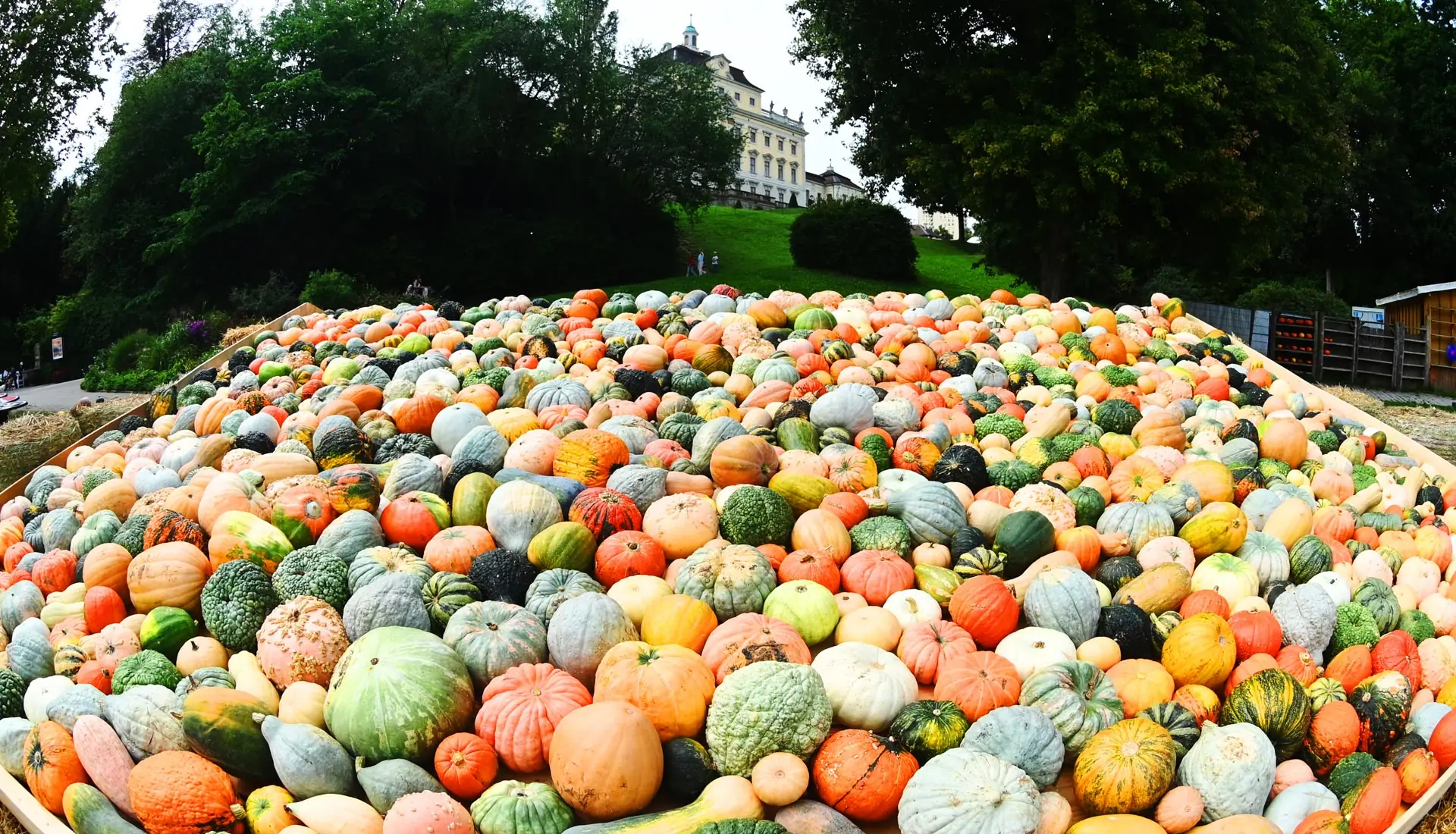They are orange, yellow, green, round, oval, and sometimes shaped like a crown. For 25 years, squashes of all colours and shapes have brightened the Ludwigsburg Pumpkin Festival. But visitors can do more than just look at them, some are also used as floating vessels. What began twenty years ago as a joke to test pumpkins as boats quickly evolved into a competition, and the pumpkin regatta in Ludwigsburg was born. Today, the spectacle lasts for three days and for two days, up to 120 rowers paddle to secure a place in the final. On the third day, the best eight performers from the previous year compete against this year’s top eight qualifiers.
The giant pumpkins provided by various growers for the competition are highly sought after during these days, according to event manager, Alisa Käfer who organises the pumpkin exhibition and regatta in Ludwigsburg. “Naturally, growers are reluctant to pass on the seeds of world record pumpkins – or only at exorbitant prices,” she explains. “The cost can easily run up to around 500 euros (£434).” Many regatta pumpkins are therefore by-products, once separated from the vine because space had to be created on the field for the real heavyweights. “We also always manage to get hold of some of the giant pumpkins from the official weigh-in here at the exhibition for our regatta,” says Alisa. “The optimum weight for a pumpkin boat is 250-300kg. Of course, it also depends on the strength and height of the rowers.”



Not every giant pumpkin can be used as a boat
Before a pumpkin is selected as a boat, Alisa and her team carefully check its shape. “Pumpkins with a rounder underside are better suited as a buoyant boat than those with a flat bottom,” she says. Then they are treated like Halloween pumpkins, only in XXL – the team cuts open the pumpkin and removes all the seeds. “It is important that the opening is not too deep. Otherwise, water sloshes into the pumpkin during the competition and it sinks,” she says. Before the competition, test runs are allowed and every year a few pumpkins emerge as real ‘star boats’. If multiple participants choose the same pumpkin, the decision is made by drawing lots.

You can literally watch the giant pumpkin grow – it can gain up to 20kg per day!
Alisa Käfer
After the regatta, damaged pumpkins are sent to a biogas plant, while the others are used at the carving festival in Ludwigsburg for Halloween lanterns or as fire baskets. At the annual pumpkin slaughter festival at the end of the season, the flesh and seeds are given a second chance. “Every year, some visitors try to use the seeds to grow their own giant pumpkin for the next season,” says Alisa. “In the beginning, these specimens usually reach a weight of 100-150kg.” But how do you grow a squash that big?


Growing a giant pumpkin
“Like other squashes, a giant pumpkin needs around 90 to 100 days until it is ready to harvest,” explains Alisa. “What’s impressive, however, is that you can literally watch it grow – it can gain up to 20kg per day.” And it needs a lot of space for this growth – up to 150 square metres per plant. A small culinary squash plant, on the other hand, only needs one square metre, and one squash plant produces around two to five squashes. With giant pumpkins, the weaker ones are separated from the vines early on, allowing promising specimens to reach their full potential. To provide the best growing conditions, the soil is fertilised with horse manure beforehand, sufficient water provided, and the vines are regularly buried so new roots can form.


The pumpkins exhibited in Ludwigsburg come from the nearby Eisenmann fruit farm, where the farmer cultivates his squashes across 13 hectares. Harvesting takes around three weeks, with each squash checked one by one for ripeness, before being stored on the farm and delivered to the exhibition in Ludwigsburg as needed. If possible, harvesting in the rain is avoided to prevent the squashes from getting unnecessarily dirty. “While around 95 per cent were initially ornamental squashes, there are now only three varieties that are purely decorative,” says Alisa. “Nowadays, the vast majority are suitable for consumption.” For many squashes, the exhibition is just a stopover – once they have been used, they are passed on to food banks or nursery schools. This means that the squashes can be used twice, as a colourful decoration and as a tasty treat.
The squash – a true survivor

There are over a thousand different squash varieties worldwide. “Numerous new hybrids are being created in Japan, China, and Taiwan in particular, because squashes are used much more in their cuisines than here in Europe,” explains Alisa. Squashes are considered easy to grow and are used by many farmers to regenerate the soil after nutrient-demanding crops like sunflowers. If conditions are unfavourable, the squash will stop growing on its own until there are enough sun and water again – then it will continue to grow. “Farmers often swap fields with each other so that everyone can benefit from the squash,” says Alisa. “Most tend to grow strawberries and asparagus and use squashes in autumn as a hobby or for soil maintenance.”
Squashes are harvested from mid-August to mid-September. If stored correctly, they can keep for up to a year without rotting. “Demand has definitely increased in recent years,” says Alisa. “People no longer just want Hokkaido or butternut but are increasingly cooking with many other varieties too.”
